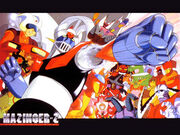| This page uses content from Wikipedia. The original article was at Mazinger Z. The list of authors can be seen in the page history. As with Super Robot Wars Wiki, the text of Wikipedia this page uses is covered by the Creative Commons License. |
- This article is about the series. For the robot, see Mazinger Z (mecha).
Mazinger Z (マジンガーZ Majingā Zetto), known briefly as Tranzor Z in the United States, is a Japanese super robot manga series written and illustrated by Go Nagai. The first manga version was serialized in Shueisha's Weekly Shōnen Jump from October 1972 to August 1973, and it later continued in Kodansha TV Magazine from October 1973 to September 1974. It was adapted into an anime television series which aired on Fuji TV from December 1972 to September 1974. A second manga series was released alongside the TV show, this one drawn by Gosaku Ota, which started and ended almost at the same time as the TV show. Mazinger Z has spawned several sequels and spinoff series, among them being Great Mazinger, UFO Robot Grendizer and Mazinkaiser.
Mazinger Z, along with Great Mazinger, made its debut in the first game from the Super Robot Wars franchise.
Plot

Mazinger Z is a gigantic super robot, constructed with a fictitious metal called Super-Alloy Z (超合金Z Chōgokin Zetto), which is forged from a new element mined from a reservoir found only in the sediment of Mt. Fuji, in Japan. The mecha was built by Professor Juzo Kabuto as a secret weapon against the forces of evil, represented in the series by the Mechanical Beasts of Doctor Hell. The latter was the German member of a Japanese archeological team, which discovered ruins of a lost pre-Grecian civilization on an island named Bardos; the civilization was loosely based on the ancient Mycenae, and was called the Mycene Empire in the series. One of their findings was that the Mycene used an army of steel titans about 20 meters in height (compare with the Greek legend of Talos).
Finding prototypes of those titans underground which could be remote-controlled and realizing their immense power on the battlefield, Dr. Hell goes insane and has all the other scientists of his research team killed except for Professor Kabuto, who manages to escape. The lone survivor goes back to Japan and attempts to warn the world of its imminent danger. Meanwhile, Dr. Hell establishes his headquarters on a mobile island, and plans to use the Mechanical Beasts to become the new ruler of the world. To counter this, Kabuto constructs Mazinger Z and manages to finish it just before being killed by a bomb planted by Hell's right-hand person, Baron Ashura, a half-man, half-woman. As he lays dying, he manages to inform his grandson Kouji Kabuto about the robot and its use. Kouji becomes the robot’s pilot, and from that point on battles both the continuous mechanical monsters, and the sinister henchmen sent by Dr. Hell.
Legacy
The series is noteworthy for introducing many of the accepted stock features of giant robot anime: The mechanical marvel that is the world's only hope, forgotten civilizations, power-hungry mad scientists, incompetent henchmen, lovable supporting characters (usually younger siblings, love interests, or friends of the hero), the scientist father or grandfather who loses his life heroically, and strangely clothed, eccentric or physically deformed villains (the intersex Baron Ashura as one example). Mazinger Z was also the first show to feature a female robot (Aphrodite A, which was piloted by Sayaka Yumi and is remembered for its missile-launching breasts), and a comic-relief robot made of spare parts and garbage named Boss Borot (which ended up suffering severe damage in nearly all of his appearances), after its pilot, brash yet simpleminded gang leader, Boss.
The peculiarity about this Super Robot, differing from the ones in earlier robot manga, is that Koji has to fly a small red hover-vehicle up to the head of the humanoid armor. The hover-vehicle, named Pilder, lands in the head of the robot and activates it (shouting PILDER ON!). Manga and anime historians see the Pilder-Robot combination as the origin of the “transforming robot” genre, because it marks one of the first published examples in a manga of two distinctive vehicles forming a specific entity. This is often interpreted as the root of later series like Go-Lion (Voltron – Defender of the Universe), the Transformers, and the giant robots in the Super Sentai Series (the basis for Power Rangers). Mazinger Z is not a vehicle that transforms into another shape, yet it requires the smaller, non-combative vehicle to get going. This idea may have inspired the Core Fighter in Mobile Suit Gundam and the entry-plug in Neon Genesis Evangelion.
Another characteristic is seen in the unusual use of Mazinger's formidable weaponry: Kouji would always announce with a shout the name of the super-power or attack he was about to use, including eye-fired laser beams ("Koshiryoku Beam!"), melting rays ("Breast Fire!"), gale-force winds ("Rust Hurricane!"), and the famous and oft-copied “Rocket Punch!” attack. Most of these simple gimmicks were later incorporated in most of Nagai’s robot series, and widely imitated in many other mecha shows. Although the roots of announcing the weapons can also be traced back to Toei's 1968 tokusatsu series, Giant Robo (US title, Johnny Sokko and His Flying Robot), or even the way the heroes of chambara eiga and television used to announce their sword techniques before cutting down their opponents.
However, the most notable characteristic that the show brought to the Super Robot genre was the relationship between machines and humans; Go Nagai established from the start the premise that machines and humans could act as one, and interact between each other. Since Kouji piloted the robot from the head, he acted as the robot's "brain", and almost every time Kouji would move, laugh, or suffer inside its cockpit, the robot would act the same, mimicking its pilot. Additionally, some minor characters included were cyborgs, that could act like humans, showing feelings and emotions (even crying). These ideas were used repeatedly in many similar shows (Grendizer, another Nagai work, would have the pilot injured in his own body where the robot was attacked).
In terms of plot, despite being all too simplistic in its portrait of good and evil characters, the show was able to stay fresh with young audiences with an irresistible mix of action, horror, comedy, and drama, sometimes all in one single episode. Some of them (specially after the introduction of the Boss Borot), were heavy on slapstick and jokes, even to the point of making fun of the hero and the villains; others carried strong melodramatic touches (this characteristics of heavy satire humor and melodrama were in fact staples of almost all of Go Nagai's creations in manga, even before their adaptations to the small screen). We also have a change in the concept of main female characters (already seen in Harenchi Gakuen, later reinforced in Cutie Honey), who were until then modeled after the "quiet, sweet, compliant" Japanese ideal: Kouji's partner and love interest Sayaka Yumi is tomboyish, loud and stubborn, very unlike the traditional heroines. Of course, Kouji Kabuto was not your usual hero of the time -- a crass, arrogant, impulsive and hot-headed ne’er-do-well -- who was the polar opposite of the virtuous Japanese males in the media. While Kouji's very outrageous and abhorrent behavior was very appealing to young boys, it was the bane of many establishment organizations, such as the Nippon PTA.
Later sequels of the franchise share many characteristics of the Japanese tokusatsu heroes as well as 1970s kaiju films. The team-up anime Grendizer & Getter Robo G & Great Mazinger vs. The Giant Sea Monster is very similar to films like Godzilla vs. the Sea Monster.

